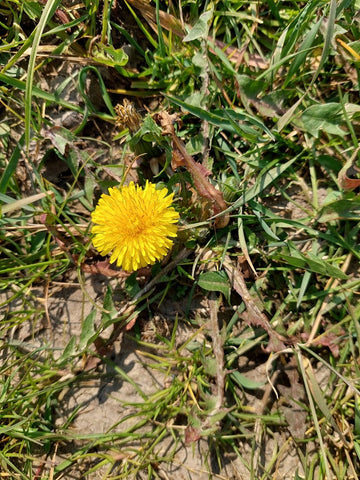The sense and nonsense of detoxing your horse
The Natural Way - specialized in itching and skin complaints and the natural treatment of horses with sweet itch, mud fever and CPL.
In recent years, detoxing has become a fashionable phenomenon. It is often advocated to use a detox treatment as standard when the leaves fall and grow (autumn and spring). But does that really make sense and what are we actually doing with the horse's body when we detox?
Also read: Detox for horses

A herb-rich pasture as a basis for a healthy balance © The Natural Way
Manual lymphatic drainage (MLD) therapist An Gybels from Equi Ikigai speaks as a guest blogger:
Priorities
The body has its own list of priorities. Sometimes there is insufficient supply of energy or nutrients and then it is quite logical that priority is given to the most important bodily functions. Highest on the priority list is homeostatic balance : maintaining temperature, blood sugar levels, oxygen pressure, blood pressure and PH.
If for some reason there are disruptive factors in the horse's environment, the removal of waste products, which is lower on the priority list, will come under pressure.
When a horse has to constantly correct the homeostatic balance, it is obliged to send its energy and nutrients there, so that they are no longer available for detoxification. A simple example of a homeostatic system under pressure is, for example, insulin resistance (IR).
The liver manages the body's insulin supply. If the liver has to make constant efforts to regulate blood sugar levels, its detoxification capacity deteriorates.
The effects of a detox
Detoxing is a much more complex process than we realize. Detoxification takes place in different phases and different types of toxins must be neutralized in their own way in a certain phase. For each phase of detoxification, our body needs different co-factors , these are specific vitamins and minerals.
The first phase is the anti-porter phase. This takes place in the intestine. Simply put, a toxin enters the body through the intestinal wall. The immune system patrols just behind the intestinal wall, recognizes the intruder and immediately sends it back out through the intestinal wall. Here lies the first pitfall. If your horse has a leaky gut due to incorrect nutrition or if your horse's immune system does not function properly, this phase is already under pressure and the horse therefore has to process a larger amount of toxins.
If toxins have entered the body, 2 scenarios are possible. In the best case, there is sufficient capacity, energy and nutrients available and the toxins are neutralized and removed.
If this is not the case, the toxins are stored in safe places in the body such as fatty tissue and connective tissue. A well-known place is under the mane crest on the neck. The mane comb then becomes thick and hard. If a midge bites it later, this will be enough for the immune system to go off the rails with all the consequences that entails.
Think of putting away those toxins as a kitchen with different cupboards. The body safely stores away the toxins it is unable to deal with in such a box so that they cannot cause any damage to the body.
Detox as a fad
Now you may have read that you need to detox your horse and therefore you give him a detox treatment. Then the detox cure walks into the kitchen, opens all the cupboards and releases all those toxins into the body at the same time. With all the consequences that entails, because there was actually no detoxification capacity because the liver was busy with something else, or there were no nutrients available, or the horse did not have enough energy for this or,...
Then those toxins - which were actually safely put away in a harmless place - now wander around in the body without the body being able to process them.
The body had other priorities and we have now overruled this priority list with our detox treatment. This causes a lot of physical discomfort for the horse and can make the complaints worse.

Dandelion (Taraxacum officinale) supports the liver © The Natural Way
What can you do then?
Taking care of homeostasis.
Ensure that the body does not have to constantly correct the homeostatic balance. Give your horse as natural food as possible, avoid sugars and grains and preferably give hay in strings.
Also read: Nutrition for itch-sensitive horses .
Ensure good intestinal health through natural nutrition, so you avoid a leaky gut and the first phase of detoxification in the intestine works optimally.
Instead of overriding the body's priority list, we can support the liver with specific vitamins and minerals that increase the liver's capacity. The liver is relieved and now has space available. The liver can then use that extra space to clean up waste products that had been put away in the body, cupboard by cupboard, shelf by shelf.
Manual lymphatic drainage (MLD) helps remove waste products. With a clean and well-functioning lymphatic system, waste products are immediately removed and do not have to be stored in the liver. This relieves the liver. Lymphatic drainage also supports the immune system.
Gemmo therapy based on embryonic plant tissue can gently support the body in removing toxins.
If all previous actions are in order, but are still insufficient, you may consider a very mild detox treatment, always in consultation with your holistic veterinarian or treating therapist.
Discover our 100 % natural Zomereczeem lotion, Mok olie, CPL olie, Natuur Shampoo and OERVOER (E-book) about healthy nutrition for itch-sensitive horses HERE.
This article was published on The Natural Way by
Laura Cleirens - 2022.03.23
Last edited: 2023.12.28
